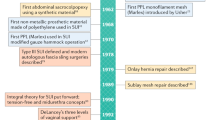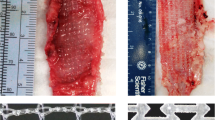Abstract
Introduction and hypothesis
Polypropylene meshes are frequently used in abdominal and vaginal reconstructive surgery. Recently, several authors have claimed that mesh-associated complications may be linked to mesh shrinkage. We have performed a prospective study with postoperative follow-up by ultrasound examination at two time points after Prolift anterior implantation to assess changes in the ultrasound appearance of mesh implants over time.
Methods
We assessed 36 patients who had undergone mesh implantation with Prolift anterior™ mesh for the correction of symptomatic anterior vaginal wall prolapse. During the surgery, we measured the actual midline length of the mesh (initial length). On the fourth postoperative day, we performed a vaginal ultrasound examination (US) to measure mesh length in the midsagittal plane. A second US was performed 3–5 months after surgery to repeat this measurement.
Results
There was a significant difference in mesh length determined before and 4 days after surgery (90.3 vs. 57.1 mm, P = <0.0001) indicating intraoperative folding. On comparing early and late postoperative ultrasound measurements, there was a reduction in length from 57.1 to 48.3 mm (P < 0.0001), indicating possible shrinkage or retraction.
Conclusions
Intraoperative folding seems to be responsible for a large part of the difference between preoperative (in vitro) and postoperative (US) measurements of mesh dimensions, suggesting that surgical techniques may require adjustment.


Similar content being viewed by others
Abbreviations
- POP-Q:
-
Pelvic organ prolapse quantification system
- US:
-
Ultrasound
- ICC:
-
Intraclass correlation
- CT:
-
Computer tomography
- MR:
-
Magnetic resonance
References
Maher C, Baessler K, Glazener CM, Adams EJ, Hagen S (2008) Surgical management of pelvic organ prolapse in women: a short version Cochrane review. Neurourol Urodyn 27:3–12
Feiner B, Maher C (2010) Vaginal mesh contraction: definition, clinical presentation, and management. Obstet Gynecol 115:325–330
Letouzey V, De Tayrac R, Deffieux X, Fernandez H (2008) Long-term anatomical and functional results after trans-vaginal cystocele repair using a tension-free polypropylene mesh. Int Urogynecol J Pelvic Floor Dysfunct 19:S82–S83
Velemir L, Amblard J, Fatton B, Savary D, Jacquetin B (2010) Transvaginal mesh repair of anterior and posterior vaginal wall prolapse: a clinical and ultrasonographic study. Ultrasound Obstet Gynecol 35(4):474–480
Sergent F, Desilles N, Lacoume Y, Bunel C, Marie JP, Marpeau L (2009) Experimental biomechanical evaluation of polypropylene prostheses used in pelvic organ prolapse surgery. Int Urogynecol J Pelvic Floor Dysfunct 20:597–604
Mamy L, Letouzey J, Lavigne J, Garric X, Mares P, De Tayrac R (2009) Correlation between contraction and infection of implanted synthetic meshes, using an animal model of mesh infection. Int Urogynecol J Pelvic Floor Dysfunct 20:S167
Cobb WS, Burns JM, Peindl RD, Carbonell AM, Matthews BD, Kercher KW, Heniford BT (2006) Textile analysis of heavy weight, mid-weight, and light weight polypropylene mesh in a porcine ventral hernia model. J Surg Res 136:1–7
Klinge U, Klosterhalfen B, Birkenhauer V, Junge K, Conze J, Schumpelick V (2002) Impact of polymer pore size on the interface scar formation in a rat model. J Surg Res 103:208–214
Konstantinovic ML, Pille E, Malinowska M, Verbeken E, De Ridder D, Deprest J (2007) Tensile strength and host response towards different polypropylene implant materials used for augmentation of fascial repair in a rat model. Int Urogynecol J Pelvic Floor Dysfunct 18:619–626
Tunn R, Picot A, Marschke J, Gauruder-Burmester A (2007) Sonomorphological evaluation of polypropylene mesh implants after vaginal mesh repair in women with cystocele or rectocele. Ultrasound Obstet Gynecol 29:449–452
Dietz HP, Barry C, Lim YN, Rane A (2005) Two-dimensional and three-dimensional ultrasound imaging of suburethral slings. Ultrasound Obstet Gynecol 26:175–179
Masata J, Martan A, Svabik K, Drahoradova P, Pavlikova M, Hlasenska J (2005) Changes in urethra mobility after TVT operation. Ceska Gynekol 70:220–225
Debodinance P, Berrocal J, Clave H, Cosson M, Garbin O, Jacquetin B, Rosenthal C, Salet-Lizee D, Villet R (2004) Changing attitudes on the surgical treatment of urogenital prolapse: birth of the tension-free vaginal mesh. J Gynecol Obstet Biol Reprod (Paris) 33:577–588
Svabik K, Martan A, Masata J, El Haddad J (2009) Vaginal mesh shrinking—ultrasound assessment and quantification. Int Urogynecol J Pelvic Floor Dysfunct 20:S166
Fischer T, Ladurner R, Gangkofer A, Mussack T, Reiser M, Lienemann A (2007) Functional cine MRI of the abdomen for the assessment of implanted synthetic mesh in patients after incisional hernia repair: initial results. European Radiology 17:3123–3129
Boukerrou M, Boulanger L, Rubod C, Lambaudie E, Dubois P, Cosson M (2007) Study of the biomechanical properties of synthetic mesh implanted in vivo. Eur J Obstet Gynecol Reprod Biol 134:262–267
Acknowledgements
This work was supported by the Grant Agency of the Ministry of Health of the Czech Republic, grant NR/9216-3.
Conflicts of interest
A. Martan provides consultation for Gynecare, Bard, and AMS.
Author information
Authors and Affiliations
Corresponding author
Rights and permissions
About this article
Cite this article
Svabík, K., Martan, A., Masata, J. et al. Ultrasound appearances after mesh implantation—evidence of mesh contraction or folding?. Int Urogynecol J 22, 529–533 (2011). https://doi.org/10.1007/s00192-010-1308-9
Received:
Accepted:
Published:
Issue Date:
DOI: https://doi.org/10.1007/s00192-010-1308-9




